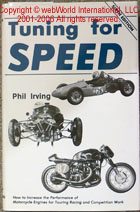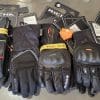First published in 1948 by Temple Press
Hardcover; Dimensions: 9″x5.75″x1″ (22.7×14.6×2.6 cm)
ISBN: 0908031297
Can be found for approx. $40.00 wBW Reviews Home | Book Reviews Index
This is the second in our occasional series of reviews of classic motorcycle books. Some of these books some are very rare; some are out of print, obscure, forgotten or generally out of the mainstream.
I have always been of the opinion that deepening our understanding and knowledge of what has come before can help us better appreciate what we now have and what will come in the future. Our hope is that you will discover something new, just as we have, and that you will become as inspired as we have been to deepen your knowledge of motorcycling history.
Tuning for Speed should be on the top 10 list of just about everyone’s motorcycle classic book list. The name Phil Irving may not be as well known today to some and possibly less so in the United States. But Irving has been called “one of the most underrated designers in the history of world motorsport”, and Tuning for Speed has been called “one of the best books ever written on the improvement of motorcycle engines”.
Phil Irving was a brilliant designer and engineer, but he also had a wonderful ability for communicating this knowledge to others. Among his many credits are his contributions as Chief Engineer for one of the most desired classic motorcycles of all time: the pre-World War II Vincent-H.R.D. models. He also designed the Velocette adjustable rear suspension system and the stressed steel frame, the basic design of which is still used in motorcycles today, and he has written several books on the design and tuning of engines.
Tuning for Speed is one of my all-time favorites in the technical book genre, and it sits on the shelf in a place of honor next to my ancient copy of Design and Tuning of Competition Engines by Philip H. Smith (and the much more recent Motorcycle Dynamics by Vittore Cossalter).
I can’t profess to understand everything that is discussed in any of these books, but I have certainly tried over the years, and I occasionally pull one down and browse through a couple of chapters, amazed at both the differences and similarities in motorcycle and engine design and tuning over the decades.
Tuning for Speed was originally aimed at both motorcycle enthusiasts and racers who wanted to maximize the efficiency of their engines. The subtitle of the book is “How to Increase the Performance of Motorcycle Engines for Touring, Racing and Competition Work”. It’s written as a sort of “how to” manual, for those engines, carburetors and drive trains of yore, which were certainly much simpler to maintain. So although much of the information can’t be put to immediate use, the theory and engineering that is discussed is as sound as ever.
Readers may find that they can deepen their understanding of the ever-fascinating controlled internal combustion process that takes place inside of an engine. They may find that there are still a few long-lost tricks and techniques that can be applied to today’s screaming power plants. At the very least, the explanations of how things work are like a short course in mechanical engineering.
This isn’t a book that can be read straight through, cover to cover. It’s something to be studied, a chapter or two at a time. The tone of the writing is matter-of-fact; as if Irving himself is speaking to the reader, letting loose with his secrets.
Topics covered include basic Carburetion and Gas Flow, Cylinder Heads, Pistons and Rings, Truing and Balancing Flywheels, The Valve Mechanism, Adjustments to Valve Timing and even a couple of chapters on Supercharging and “Sparking Plugs”. Don’t forget that this is not simply basic information; it’s a relaying of the knowledge that the Master — Phil Irving — collected through the years. The book went through at least 12 different printings that I’m aware of since it was first published in 1948, with some sell-outs requiring second and even third impressions.
Anyone interested in the history, design and theory of motorcycle engines should have a copy of this classic on their shelves. This one isn’t too hard to find; most old-time motorcycle booksellers (especially in Australia, Phil Irving’s birthplace) either have a reprint or can find you a copy.
The wBW Rare Motorcycle Book Review Series: Grace and Grit: Motorcycle Dispatches From Early Twentieth Century Women | Triumph Bonneville: Portrait of a Legend | 60 Years of MotoGP | Hold ON! by Stan Dibben | Classic Motorcycling: A Guide for the 21st Century | The Rugged Road by Theresa Wallach | Exotic Motorcycles by Vic Willoughby | Fay Taylour – Queen of Speedway | Fifteen Times by Giacomo Agostini | Historic Racing Motorcycles, Famous Racing Motorcycles and Built for Speed by John Griffith | Great Motorcycle Legends by Richard Renstrom | Bahnstormer by L.J.K. Setright | British Motorcycles of the 1930’s | Tuning for Speed by Phil Irving | Café Racers by Mike Clay | Tuning for Speed by Phil Irving | Bill Lomas: World Champion Road Racer | More wBW Book Reviews | wBW Book Review Ratings
wBW Rating:
![]()
![]()
![]()
![]()
![]()
![]()
![]()
![]()
The wBW “Flaming Helmet” Book Review Rating System | Book Reviews Home
Note: For informational use only. All material and photographs are Copyright © webWorld International, LLC – 2000-2013. All rights reserved. See the webBikeWorld® Site Info page. NOTE: Product specifications, features and details may change or differ from our descriptions. Always check before purchasing. Read the Terms and Conditions!



